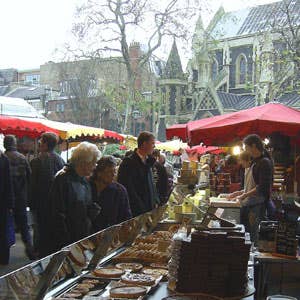
Market Watch
On Sunday mornings, London comes alive with markets and the spirit of the ghosts who have haunted their stalls for centuries. In the East End, early risers can still stroll nearly a mile from Hackney Road to Liverpool Street amid hawkers' cries and jostling crowds. At Columbia Road, a morning flower market spills over with colorful booths selling bulbs, cut flowers, and plants, while on Bethnal Green Road, fruit and vegetable traders shout—"Pound a bowl!", "Bowl for a pouunnnd!"--as they hand over sagging bags of squishy tomatoes. By nine o'clock, the sidewalks of Brick Lane are packed with queues outside the bagel shops and dotted with sidewalk blankets where young artists sell knit hats and vintage leather belts.
The neighborhood's hub, however, is Spitalfields Market, an airy Victorian arcade of narrow aisles and enticing aromas. Food stalls and picnic tables rim the market, providing a perch for customers hunched over steaming paper boxes of chicken curry or steak pie. In the center of it all, past a cheerful stand selling Caribbean cds and a table stacked high with pastries, sit the crafts booths, festooned with woven bags, beaded earrings, and wool jackets. Women try on skirts over their jeans or behind a hastily rigged white curtain at the back of the stalls, while browsers weave in and out of the dawdling crowd.
Not all London's markets are so vibrant, though. In the 1830s, Dickens wrote that in the hour before sunrise, the area around London's great Covent Garden market was "strewed with decayed cabbage-leaves, broken hay-bands, and all the indescribable litter of a vegetable market; men are shouting, carts backing, horses neighing, boys fighting, basket-women talking, pie men expatiating on the excellence of their pastry, and donkeys braying". Today the only shouts are from the street performers and drunks who flock to the district, and the market itself has been scrubbed like a mall. Flimsy wooden carts pose as replicas of those of Dickens's time, and they now sell plastic bracelets, not cabbages. And the 300-year-old produce market has migrated to a massive warehouse in Vauxhall, where it is surrounded by a chain-link fence and long parking bays.
Thankfully, London's other great food hub has remained more faithful to its historic origins. Borough Market, located in Southwark, just east down the Thames from Shakespeare's Globe theater, has roots in London that reach back before the Roman invasion and has occupied its current site for 250 years. There, wholesale trading still goes on into the wee hours every night; walk by at eight o'clock, when business has finished for the morning, and the pavement is stuck with lettuce leaves, as if left by Dickens's basket-women. On weekends, the market is transformed into an everyman's gastronomic paradise, where stacks of brownies stand beside crumbled samples of stilton and cooks serve fresh lamb burgers with caramelized onions amid piles of rough-skinned apples.
In the City, the historic core of London, meat trading at Smithfield Market also continues on its centuries-old spot. In the predawn silence, silhouettes in white coats and hard hats dart between beeping lorries and refrigerated trucks, ferrying carts piled with bloody sacks, while at loading docks hooks convey carcasses inside. The market building is an ornate confection of gleaming white and purple paint, but the air around it reeks with the primal scent of fresh meat. Both sanitized and gruesome, piles of whole fuzzy hooves rest in cardboard boxes, livers glisten under fluorescent lights, cases are stacked with sleepy-eyed pigs' heads, and wisplike marbling weaves through deep red flanks of beef. Around the market, plain cafes serve greasy English breakfasts and pubs pull their first pints.
As the city grows and changes, though, it remains to be seen whether London's historic markets will survive another century. Already development threatens Southwark, where Britain's National Rail has proposed to expand the train tracks that run above Borough Market. In the past decade, Spitalfields has also been encroached on by shiny condominiums and chain restaurants, and the market has almost halved in size. For now, locals continue to fight vigorously to preserve what is left. Few traces may remain of the Dickensian East Enders who once overflowed the aisles, but London's markets still echo with their cries.
Borough Market
8 Southwark Street
Tube: London Bridge
Public stalls open Thursday 11-5, Friday 12-6, Saturday 9-4
Where to eat:
Northfield Farm, Borough Market
Brindisa, Borough Market
Flour Power Bakery, Borough Market
Monmouth Coffee, Stoney Street
Konditor and Cook, Stoney Street
Smithfield Market
Charterhouse Street
Tube: Farringdon/Barbican
Monday-Friday 4 a.m.-12 p.m.; busiest before 8 a.m.
Spitalfields Market
105 Commercial Street
Tube: Liverpool Street
Open daily 10-4; Sunday is the busiest day, 9-5
Where to eat:
Square Pie Company, Spitalfields Market
Market Coffee House, 52 Brushfield Street
Story Deli, 3 Dray Walk, Old Truman Brewery
Keep Reading
Continue to Next Story










